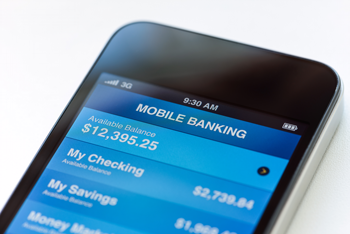 Banks keep making banking easier, and that means cutting down on branch visits or eliminating them altogether by giving customers really great mobile apps. Perhaps more than any type of business, banking and financial services firms increasingly rely on the sophistication and ease-of-use of their mobile applications to attract new customers and keep them. They also have to be secure. These apps have gone far beyond checking balances. Today’s banking and financial customers can transfer funds, pay people, pay bills, deposit checks, trade stocks, and make payments with their mobile.
Banks keep making banking easier, and that means cutting down on branch visits or eliminating them altogether by giving customers really great mobile apps. Perhaps more than any type of business, banking and financial services firms increasingly rely on the sophistication and ease-of-use of their mobile applications to attract new customers and keep them. They also have to be secure. These apps have gone far beyond checking balances. Today’s banking and financial customers can transfer funds, pay people, pay bills, deposit checks, trade stocks, and make payments with their mobile.
For many banking customers—particularly younger ones banking for the first time who see much of the world through a screen in their hands—a visit to a bank branch can be more of a nuisance than an opportunity to see how safe their money is. How better to get new customers than to make the onboarding process as quick and painless as possible? Mobile onboarding is the next frontier. It gets customers almost effortlessly, even if for a small account or credit line to start. Every empire starts somewhere.
Banks offering mobile onboarding need to ensure that fraudsters are prevented from exploiting the service. Identity proofing is essential. There are several ways that biometrics can be used to ensure identity proofing is done right.
Mobile ID checks. When signing up for a new account at a branch, the applicant provides proof of identity; most typically, a driver’s license. What does the officer do with it? They check that the face on the ID is the same as the one sitting in their office. Biometric algorithms can do this for us; some would say better than humans can. The reason is because while we’re all really good at recognizing someone we’ve seen a few hundred-thousand times, but we are notoriously bad at one-to-one comparisons. Facial recognition algorithms should include liveness detection measures that make it difficult to impersonate someone by using a fake image in place of a live one.
ID document authentication. Bank officers are also not necessarily trained at recognizing fake IDs. But there’s an app for that. We can use software to capture and analyze the security features of an ID to help ensure it’s not a fake.
Known fraudster checks. Fraudsters don’t tend to use their real identity information to open accounts. This is why biometrics can be useful to identify them anyway. It’s possible to use their biometrics such as their facial image to search databases of known fraudsters. If there’s a hit, its likely prudent to bring them to a branch for further screening after all.
The need for bank branches fades as new payment methods further reduce the use of cash. But customers will still need a trusted relationship with their banks. Biometrics and other technologies are helping banks get new customers and provide them high-value services without having to get them physically to a branch first. You can learn more about mobile banking innovations at Mobey Day taking place in Barcelona next week.